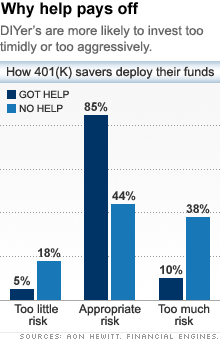Search News
(MONEY Magazine) -- Should I hire a financial adviser to manage my retirement portfolio, and can I afford to? -- Robert Stamberger, Fallbrook, Calif.
The answer depends largely on how comfortable you are going it alone -- and how good a job you think you could do overseeing your finances without help from a pro.

Let's start with one key aspect of retirement planning: investing. As long as you're familiar with the concept of asset allocation and you're comfortable picking funds, you shouldn't have trouble building a diversified portfolio on your own.
And you can get plenty of assistance short of hiring an adviser: These days most 401(k) plans provide tools to help you assess your investing options and assemble an appropriate lineup for your age and risk tolerance.
You can also find plenty of guidance online. Morningstar's Asset Allocator tool (free at T. Rowe Price's website) will show you the risk and return potential for different mixes of stocks and bonds. You can pick specific investments using Morningstar's Fund Screener or our MONEY 70 list of recommended funds. With this DIY approach, the money you would have paid an adviser is yours to keep.
The case for advice
The problem is, if you screw up, you can end up losing a lot more than you might save. In a recent study, benefit consultant Aon Hewitt and advice firm Financial Engines looked at the 401(k) returns of more than 425,000 savers from 2006 through 2010.
The findings: The median annual return of those who got professional help was almost three percentage points higher than the return for those who invested on their own, even after taking fees into account.
One reason for that performance gap is that the investors who flew solo were far more likely to be too aggressive or too conservative (see graphic). Emotions also played a role: Do-it-yourselfers were more apt to cash out of stocks in the 2008 crash. As a result, their returns lagged substantially when the market rebounded in 2009.
Getting investing help can be as simple as signing up for online fund recommendations or buying a target-date fund -- a fully diversified stock and bond portfolio that becomes more conservative as you age. At least two-thirds of plans offer them. About a third of 401(k)s also have a managed-account option, which lets you turn your money over to an adviser to handle, for an annual fee of 0.3% to 0.75% of assets.
Outside your workplace plan, the investment advisory services at many fund companies and brokerages will manage a portfolio for 0.25% to 1% or more a year. Or you can hire an independent financial pro -- you can get the names of certified financial planners in your area through the Financial Planning Association's Find a Planner tool. Fees vary widely, but expect to pay about 1% of assets, plus underlying investment expenses. Some advisers, such as those at Garrett Planning Network, work for an hourly fee, typically between $150 and $240.
A shot at better investment returns isn't the only reason to seek help. During your working days, sticking with a sufficient savings rate is crucial. Setting aside 12% to 15% a year (including a company match) is an oft-cited rule of thumb, yet a 2011 Vanguard study estimated that fewer than a third of 401(k) participants put away that much.
You can come up with your own savings goal with our Retirement Planner tool, which shows how different savings rates affect your chances of maintaining your standard of living. What a planner can add is help freeing up money in your budget if you're not saving enough.
Planning perils
While you're saving for retirement, you have plenty of free tools to guide you, plus low-cost access to professional help through target-date funds. But as you near the end of your career, the stakes go up.
Turning your retirement savings into a reliable income is essential, and that can be daunting to tackle on your own. An October report from MetLife found that 40% of pre-retirees believe they can spend 7% or more each year without depleting their savings -- most advisers consider 4% to 5% a safe withdrawal rate.
With T. Rowe Price's Retirement Income Calculator, you can calculate the probability that your savings will support you. What gets complicated is managing that income stream for decades.
T. Rowe Price fund investors can pay $250 to have the firm suggest a withdrawal rate and portfolio mix. Morningstar, Financial Engines, and another 401(k) advice firm, GuidedChoice, offer a retirement income service, often as part of a managed account.
For now, though, you can sign up only if you're in the minority of 401(k) plans that offer it. Your best option may be a financial planner. Hiring an adviser is never your only choice, but at this late stage it can be an especially wise decision. ![]()

Carlos Rodriguez is trying to rid himself of $15,000 in credit card debt, while paying his mortgage and saving for his son's college education.
| Overnight Avg Rate | Latest | Change | Last Week |
|---|---|---|---|
| 30 yr fixed | 3.80% | 3.88% | |
| 15 yr fixed | 3.20% | 3.23% | |
| 5/1 ARM | 3.84% | 3.88% | |
| 30 yr refi | 3.82% | 3.93% | |
| 15 yr refi | 3.20% | 3.23% |
Today's featured rates: